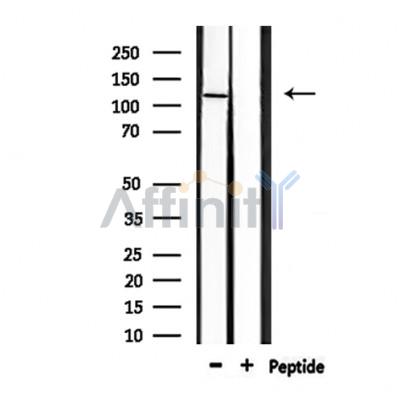产品描述
*The optimal dilutions should be determined by the end user.
*Tips:
WB: 适用于变性蛋白样本的免疫印迹检测. IHC: 适用于组织样本的石蜡(IHC-p)或冰冻(IHC-f)切片样本的免疫组化/荧光检测. IF/ICC: 适用于细胞样本的荧光检测. ELISA(peptide): 适用于抗原肽的ELISA检测.
引用格式: Affinity Biosciences Cat# DF7951, RRID:AB_2841352.
展开/折叠
AMPA 4; AMPA selective glutamate receptor 4; AMPA-selective glutamate receptor 4; AMPA4; GluA 4; GluA4; GluR 4; GluR D; GluR-4; GluR-D; GluR4; GLUR4C; GLURD; Glutamate receptor 4; Glutamate receptor ionotrophic AMPA 4; Glutamate receptor ionotropic; GRIA 4; Gria4; GRIA4_HUMAN;
抗原和靶标
- P48058 GRIA4_HUMAN:
- Protein BLAST With
- NCBI/
- ExPASy/
- Uniprot
MRIISRQIVLLFSGFWGLAMGAFPSSVQIGGLFIRNTDQEYTAFRLAIFLHNTSPNASEAPFNLVPHVDNIETANSFAVTNAFCSQYSRGVFAIFGLYDKRSVHTLTSFCSALHISLITPSFPTEGESQFVLQLRPSLRGALLSLLDHYEWNCFVFLYDTDRGYSILQAIMEKAGQNGWHVSAICVENFNDVSYRQLLEELDRRQEKKFVIDCEIERLQNILEQIVSVGKHVKGYHYIIANLGFKDISLERFIHGGANVTGFQLVDFNTPMVIKLMDRWKKLDQREYPGSETPPKYTSALTYDGVLVMAETFRSLRRQKIDISRRGNAGDCLANPAAPWGQGIDMERTLKQVRIQGLTGNVQFDHYGRRVNYTMDVFELKSTGPRKVGYWNDMDKLVLIQDVPTLGNDTAAIENRTVVVTTIMESPYVMYKKNHEMFEGNDKYEGYCVDLASEIAKHIGIKYKIAIVPDGKYGARDADTKIWNGMVGELVYGKAEIAIAPLTITLVREEVIDFSKPFMSLGISIMIKKPQKSKPGVFSFLDPLAYEIWMCIVFAYIGVSVVLFLVSRFSPYEWHTEEPEDGKEGPSDQPPNEFGIFNSLWFSLGAFMQQGCDISPRSLSGRIVGGVWWFFTLIIISSYTANLAAFLTVERMVSPIESAEDLAKQTEIAYGTLDSGSTKEFFRRSKIAVYEKMWTYMRSAEPSVFTRTTAEGVARVRKSKGKFAFLLESTMNEYIEQRKPCDTMKVGGNLDSKGYGVATPKGSSLRTPVNLAVLKLSEAGVLDKLKNKWWYDKGECGPKDSGSKDKTSALSLSNVAGVFYILVGGLGLAMLVALIEFCYKSRAEAKRMKLTFSEAIRNKARLSITGSVGENGRVLTPDCPKAVHTGTAIRQSSGLAVIASDLP
种属预测
score>80的预测可信度较高,可尝试用于WB检测。*预测模型主要基于免疫原序列比对,结果仅作参考,不作为质保凭据。
High(score>80) Medium(80>score>50) Low(score<50) No confidence
研究背景
Receptor for glutamate that functions as ligand-gated ion channel in the central nervous system and plays an important role in excitatory synaptic transmission. L-glutamate acts as an excitatory neurotransmitter at many synapses in the central nervous system. Binding of the excitatory neurotransmitter L-glutamate induces a conformation change, leading to the opening of the cation channel, and thereby converts the chemical signal to an electrical impulse. The receptor then desensitizes rapidly and enters a transient inactive state, characterized by the presence of bound agonist. In the presence of CACNG4 or CACNG7 or CACNG8, shows resensitization which is characterized by a delayed accumulation of current flux upon continued application of glutamate.
Palmitoylated. Depalmitoylated upon glutamate stimulation. Cys-611 palmitoylation leads to Golgi retention and decreased cell surface expression. In contrast, Cys-837 palmitoylation does not affect cell surface expression but regulates stimulation-dependent endocytosis (By similarity).
Phosphorylated at Ser-862 by PRKCG; phosphorylation increases plasma membrane-associated GRI4 expression.
Cell membrane>Multi-pass membrane protein. Cell junction>Synapse>Postsynaptic cell membrane>Multi-pass membrane protein. Cell projection>Dendrite.
Note: Interaction with CNIH2, CNIH3 and PRKCG promotes cell surface expression.
Homotetramer or heterotetramer of pore-forming glutamate receptor subunits. Tetramers may be formed by the dimerization of dimers. Interacts with EPB41L1 via its C-terminus (By similarity). Found in a complex with GRIA1, GRIA2, GRIA3, CNIH2, CNIH3, CACNG2, CACNG3, CACNG4, CACNG5, CACNG7 and CACNG8. Interacts with CACNG5 and PRKCG (By similarity).
The M4 transmembrane segment mediates tetramerization and is required for cell surface expression.
Belongs to the glutamate-gated ion channel (TC 1.A.10.1) family. GRIA4 subfamily.
研究领域
· Environmental Information Processing > Signal transduction > cAMP signaling pathway. (View pathway)
· Environmental Information Processing > Signaling molecules and interaction > Neuroactive ligand-receptor interaction.
· Human Diseases > Substance dependence > Amphetamine addiction.
· Organismal Systems > Environmental adaptation > Circadian entrainment.
· Organismal Systems > Nervous system > Retrograde endocannabinoid signaling. (View pathway)
· Organismal Systems > Nervous system > Glutamatergic synapse.
· Organismal Systems > Nervous system > Dopaminergic synapse.
限制条款
产品的规格、报价、验证数据请以官网为准,官网链接:www.affbiotech.com | www.affbiotech.cn(简体中文)| www.affbiotech.jp(日本語)产品的数据信息为Affinity所有,未经授权不得收集Affinity官网数据或资料用于商业用途,对抄袭产品数据的行为我们将保留诉诸法律的权利。
产品相关数据会因产品批次、产品检测情况随时调整,如您已订购该产品,请以订购时随货说明书为准,否则请以官网内容为准,官网内容有改动时恕不另行通知。
Affinity保证所销售产品均经过严格质量检测。如您购买的商品在规定时间内出现问题需要售后时,请您在Affinity官方渠道提交售后申请。产品仅供科学研究使用。不用于诊断和治疗。
产品未经授权不得转售。
Affinity Biosciences将不会对在使用我们的产品时可能发生的专利侵权或其他侵权行为负责。Affinity Biosciences, Affinity Biosciences标志和所有其他商标所有权归Affinity Biosciences LTD.


